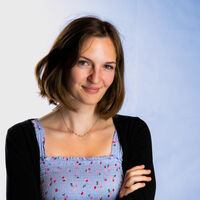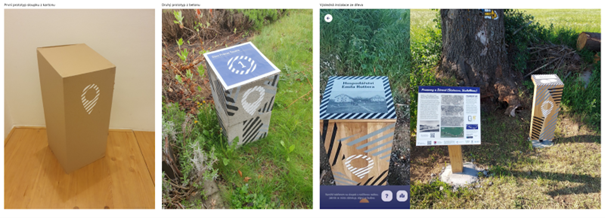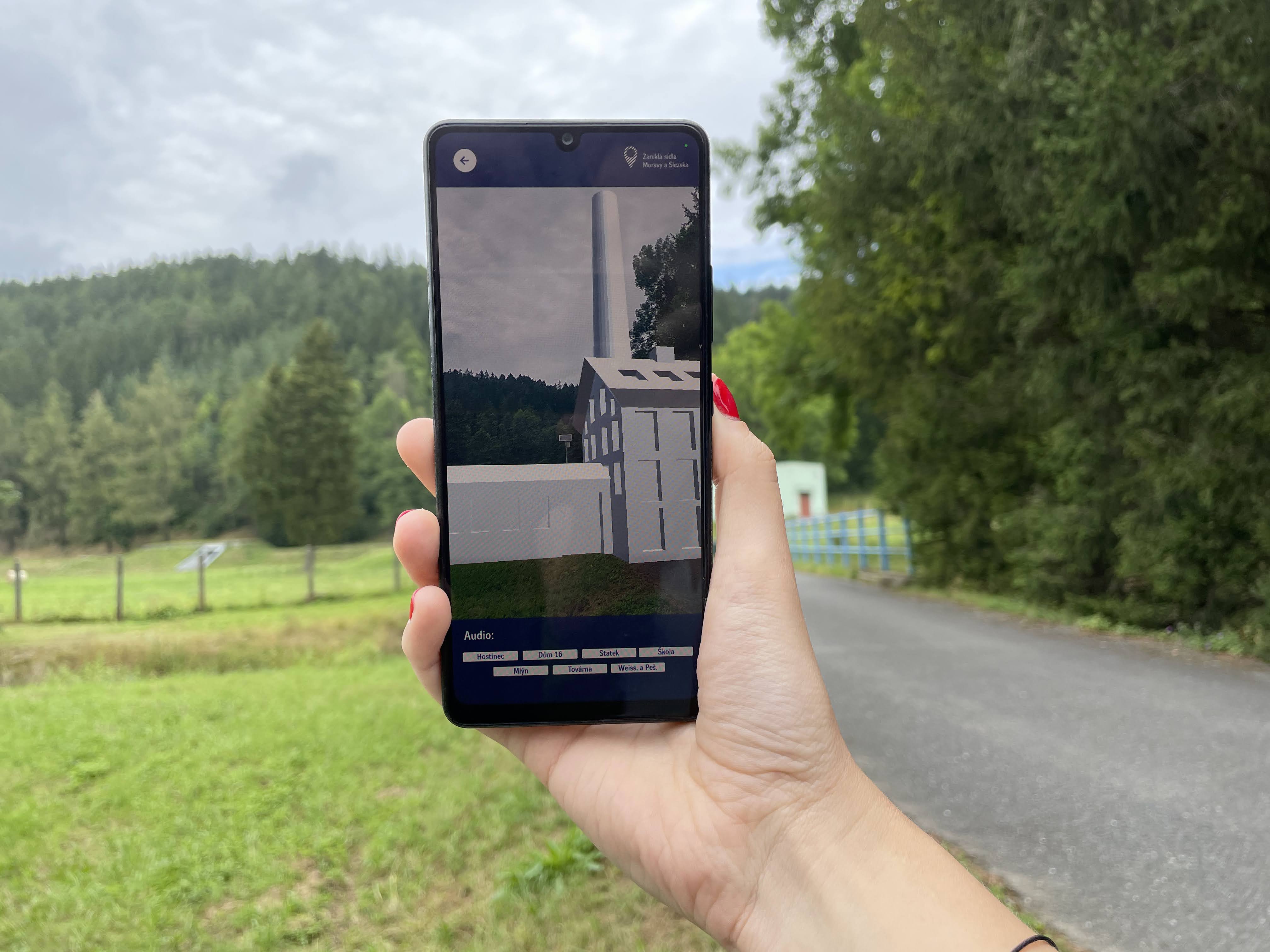The defunct village of Štolnava lives on in an expanded reality

Since there were no fixed objects in the vanished village to anchor the location of the augmented reality, I had to devise a way to artificially create these points.
Radka Grace for fi.muni.cz
Meet Bc. Šárka Portešová, an exceptionally active student of the Visual Informatics Master's programme at the Faculty of Informatics. Šárka has not only won several awards for her bachelor thesis on the reconstruction of the defunct village of Štolnava using augmented reality, but she is also actively involved in the promotion of the faculty and designed the graphic design of a new brochure for high school students. In this interview, learn more about her inspiring project to reconstruct the defunct village of Štolnava, the challenges she faced, and what motivates her to continue her creative efforts.
Hello Šárka, in this interview we will focus on your final bachelor thesis entitled "AR reconstruction of the vanished village of Štolnava", for which you also won the FI Dean's Award for Outstanding Final Thesis. Could you please start by introducing yourself?
Hello, thank you for the invitation. At the Faculty of Informatics I studied applied informatics with a specialization in graphic design as part of my bachelor's degree and now I am continuing my master's studies in visual informatics, again with a specialization in graphic design. And I am also studying at the Faculty of Arts in the field of Information Studies and Librarianship, within which I am also focusing on service design and technology in education. It seems to me that this and computer science connect and complement each other nicely.
Now let's focus on your bachelor's thesis. How did you come up with the idea of reconstructing the defunct village of Štolnava using augmented reality?
I didn't come up with the idea on my own. I was interested in the offer of Mgr. Lukáš Pevný's offer to join the project "Vanished settlements of Moravia and Silesia", which was led by an interdisciplinary team of experts from Mendel University, Masaryk University and the Academy of Sciences. I was enthusiastic about this project right from the start, especially because part of the design included the inclusion of augmented reality in the app for visitors to the extinct settlement of Prameny (formerly Štolnava), located in the Šumperk district.
What were the main challenges you faced in the implementation of this project?
There were several challenges. The main challenge was figuring out what type of augmented reality to use to display buildings in their actual size in a place where nothing exists today. The site is just a dirt road, woods and meadows. The only relics that remain of the original village are the reconstructed church floor plan and the cemetery.
As part of your thesis, you did research on historical sources and the terrain - how did it go and what information did you get?
First, together with the project researchers, we went to the site of the defunct settlement. This gave me an idea of what the whole site actually looks like and what processing possibilities it offers. Then I got to know the history of the settlement and especially the original photographs that captured some views of the village and specific buildings. Based on these photographs, I created 3D models and started thinking about how to provide visitors with more interesting information about the history of the village through the app. This is how I started to create the additional function of an audio guide.

How did you go about choosing specific technologies and tools? Can you describe how you overcame the challenges of compatibility between different platforms and devices?
The selection of tools and technologies was based on several criteria. I tried to take into account the possibilities offered by the location (e.g. mobile data availability) as well as the possibilities of a believable display. Since there were no fixed objects in the defunct village to anchor the augmented reality location, I had to devise a way to artificially create these points. I came up with the idea of creating posts and placing them on the locations of the original buildings as a suitable solution. The idea of bollards was chosen not only with regard to the technical solution, but also to symbolically line the main road and guide visitors through this defunct settlement. I was a bit apprehensive about the technical solution, so I tried to test this approach first at least in an alternative setting in our garden with a life-size cardboard prototype. This approach worked well based on testing, and I was able to move on to the next challenges.
Can you describe the process and key aspects you considered when designing the user interface of the app? How did you ensure the app was user-friendly?
As only a small proportion of users have experience of augmented reality, I knew that creating instructions on how to use this functionality would be a necessary part of the process. I also created additional explanatory images for this. I tried to design the application flow to be as intuitive as possible for users of any age. Last but not least, the choice of colour was key, not only from an aesthetic point of view but also from a functional one. The app's sufficiently high contrast colour scheme allows it to be used outdoors, even in bright sunlight. I first created this entire prototype in Figma, so that I could test it before implementation and, if necessary, easily modify it.
What were the biggest technical challenges in implementing the app?
After consulting with my thesis advisor and consultants, I chose the appropriate tools to implement the app. Some I knew, but others I had to learn to work with. As I mentioned before, anchoring augmented reality to objects in the real space of the original village was a certain challenge. Another unexpected challenge was the choice of material and the overall design of the visual aspect of the posts so that they fit into the landscape, were able to withstand the harsh meteorological conditions of the site, and at the same time allowed for a reliable augmented reality representation of the objects.

Have you tried AR with respondents in the field? How many were there and what were their reactions?
Since the village of Prameny is quite far from my home and the final columns have not yet been created, I had to find a way to test the application appropriately under these difficult conditions. So I chose the environment of Brno's Lužánky Park, which allowed me to simulate the natural character of the village and the objects that functionally mimicked the future columns. Thus, the application was tested by 14 respondents. During the on-site testing, I observed how the respondents interacted, what their first impressions were and any incomprehensibilities. The reactions were universally positive. I then sent out a questionnaire to the respondents, which showed that the app was quite intuitive for users. Some of them also mentioned partial problems, on the basis of which I subsequently modified the application.
Do you see the possibility of extending this project to other defunct municipalities or historical monuments?
The idea of extending this application was already conceived after the submission of my bachelor thesis. The suggestion for further extension came from the project's researchers. Specifically, a similar application was implemented in the defunct village of Muzlov (click on the link to see a video demonstration of the AR of the defunct village of Muzlov). The implementation took place in the spring of this year. (Interviewer's note: The mapped defunct villages can be found on this website: zanikla-sidla.cz)

Your work is admirable and very interesting. So let us return to what we mentioned in the introduction, namely that you have won the Dean's award for an outstanding thesis. Congratulations on receiving this award. What does this award mean to you?
Thank you for your congratulations. I am very pleased with the award and I see it as an encouragement to continue my efforts. However, the biggest motivation for me is the opportunity to create and participate in something meaningful and interesting, which this project has definitely fulfilled (smile).
I also won the Czechitas Award for the best end-to-end solution for my bachelor thesis, which I was also very pleased about.
What did you enjoy most about this project?
As I mentioned earlier, I most enjoy creating something creative and at the same time something that has a real application. The process of making the app involved a variety of different activities, from creating 3D models, finding historical sources, designing the columns, to the actual implementation. All of this together was very interesting and fun. And of course, I am delighted that the project has actually come to fruition, that the columns are now embedded in the field and the app is freely available for visitors to download.

What would you recommend to students interested in working on similar projects?
Either have your own topic and go for it, or don't be afraid to show interest in getting involved in projects, of which there are many at the Faculty of Computer Science. And above all, don't be afraid to ask! I think the lecturers will be happy to see your interest.
Thank you for letting us know about your bachelor thesis project. Congratulations on your success and we wish you continued success in your further studies and that you are happy in practice and in your personal life.
You can follow Sarka and her work on her website: sarkaportesova.com
You can find her award-winning thesis here: AR reconstruction of the vanished village of Štolnava